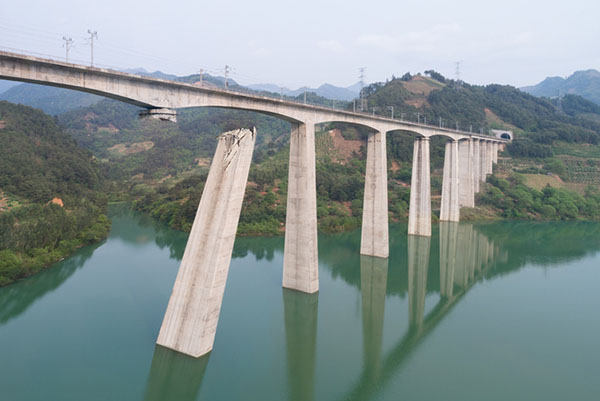Deteriorating bridges hasten need to spend infrastructure funds now
Transportation experts say the time is now for Congress and the Biden administration to release federal infrastructure funds to improve those unsafe bridges across the nation.
Even the well-publicized collapse of the Forbes Avenue Bridge over Fern Hollow Creek in Pittsburgh on Jan. 28—while President Joe Biden was visiting the Steel City– has not hastened release of over $1 trillion in new infrastructure funding.
There’s reason to believe the president is listening to those who say the nation has waited long enough for its rebuild.
“Make more cars and semiconductors in America,” Biden said during his State of the Union address March 1. “More infrastructure and innovation in America. More goods moving faster and cheaper in America. More jobs where you can earn a good living in America. And, instead of relying on foreign supply chains, let’s make it in America.”
In his speech, Biden said he’s committed to repairing 65,000 miles of roads and 1,500 bridges. But there’s a battle between the federal government and at least 16 governors. The feds want roads repaired; governors want the option of building new ones.
The reason for the hold-up in infrastructure spending is congressional delays in the budget approval process for the Department of Transportation. Members of Congress were hard at work speeding up that mountain of red tape while working to pass an “omnibus” spending measure by March 11.
The Infrastructure Investment and Jobs Act (IIJA), became law to much presidential fanfare last November. A continuing resolution, which held spending for federal surface transportation programs to fiscal year 2021 levels, ended Feb. 18.
Each day of delay costs the country—literally. Cost of road construction is growing by 13% annually, according to best estimates.
“The hit to the infrastructure world is even greater than it is to the broader economy,” Rick Geddes, founding director of Cornell’s Program in Infrastructure Policy, told the Wall Street Journal.
Biden administration officials are pushing back from the notion that somehow $1 trillion is lost in the Washington bureaucracy.
“That money is getting pushed out as we speak,” Mitch Landrieu, White House senior advisor, infrastructure coordinator and former New Orleans mayor, told MSNBC on March 1.
Transportation Secretary Pete Buttigieg said the administration realizes states have a strong role in how this money gets spent.
“Different states and communities have different needs when it comes to transportation assets that have to be reconfigured and modernized, expanded and added, or retired and replaced, as appropriate,” Buttigieg told Congress recently. “I want to make clear that we recognize and value the role of the states in deciding how to prioritize the use of formula dollars, as laid out in the law.”
But Buttigieg recently told a gathering of the American Association of State Highway Officials (AASHTO), “The really hard part is ahead of us: implementation.”
Business leaders are getting antsy to see money from the $1 trillion bipartisan IIJA finally get implemented.
“We urge the Biden Administration and Congress to prioritize policies and regulations that help—rather than hinder—U.S. companies to compete and lead around the world,” said Business Roundtable Smart Regulation Committee Chair Lynn J. Good, Chair, President and CEO of Duke Energy Corp. “This includes implementation of the IIJA, which represents a transformational opportunity to position our nation for the next century, while creating jobs and addressing climate change.”
Leaders from the American Road & Transportation Builders Association (ARTBA) and the American Society of Civil Engineers (ASCE) are urging Washington to unleash the pay strings as well.
According to the IIJA, DOT will provide $27.5 billion to states for bridge repairs over the next five years.
“We urge Congress to act forthwith so that the American people can begin to realize the benefits of the historic investments in the bipartisan infrastructure law.” Dave Bauer, ARTBA president and CEO, said in a statement.
In a new report on the condition of infrastructure, ARTBA estimated that 48 percent of the 619,588 U.S. bridges are rated in fair condition. The number of bridges in fair condition grew by nearly 3,000 last year, reaching 297,888 spans.
State DOTs can also use federal formula highway fund program for so-called block grant programs for bridge improvements. The total for all state-focused formula programs is expected to increase from $45 billion last fiscal year to $59 billion in FY 2023.
The newest bridges ranked in “Poor” condition include:
- Chesapeake Bay Bridge-Tunnel on Route 13, northbound in Northampton, Va.;
- US 60/62 bridge over the Mississippi River connecting Illinois and Missouri;
- 7th Street Bridge (SR 656) over the Indian River in Vero Beach, Fla.;
- US-1 Northbound over the St. Lucie River in Martin County, Fla.;
- U.S. 30 Mississippi River Bridge connecting Clinton County, Iowa, with Illinois;
- Both spans of the West Lake Houston Parkway bridge over Lake Houston, Texas;
- I-696 over I-75 just outside of Detroit, Mich.; and
- Multiple highway bridges on I-680 in Contra Costa, Calif.
West Virginia leads the nation in bridges ranked “poor.” Some 20% of all bridges in the Mountain State are rated in poor condition, the report said. Iowa, Rhode Island, South Dakota and Pennsylvania round out the lowest five.













